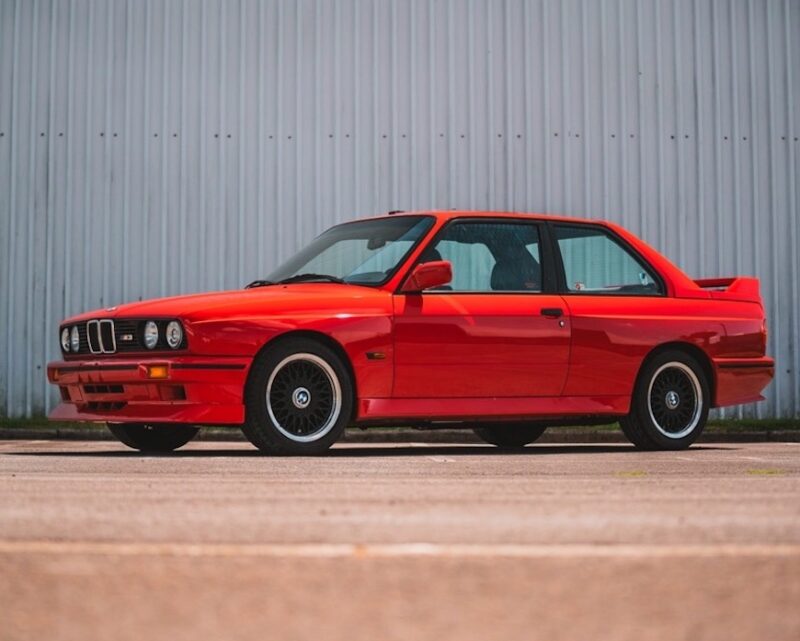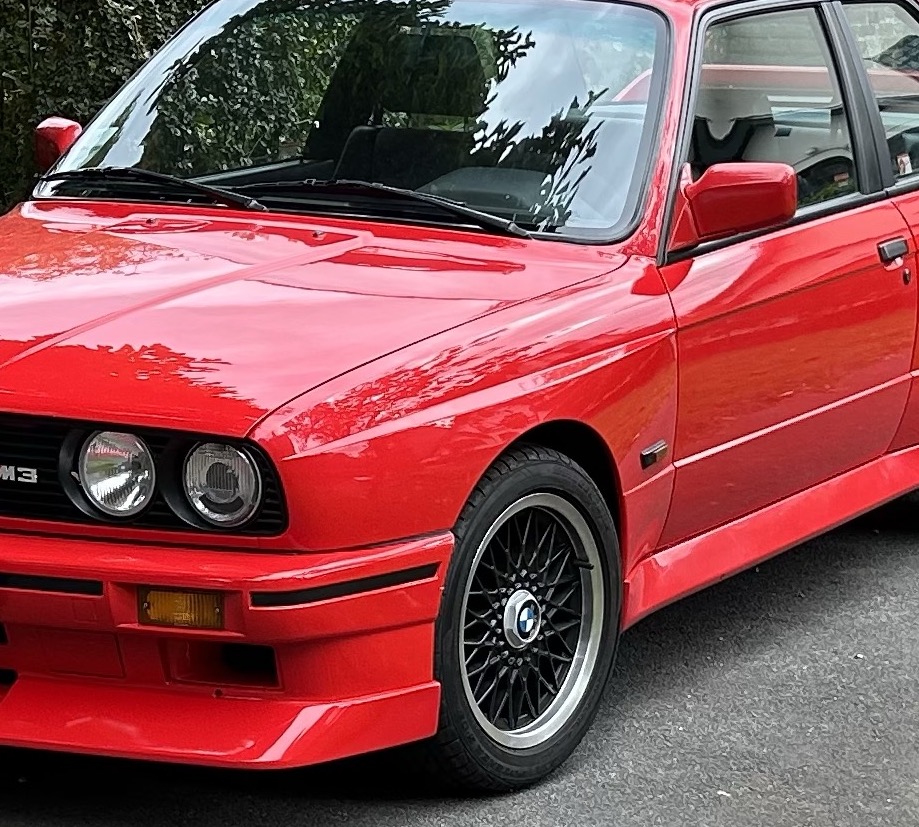1986
the FIRST M3

Designed for racing and suitable for the road
THE FIRST M3, the birth of the myth
The idea behind the first BMW M3 was to make a racing sedan available as a street version. As a touring car racing homologation model, the BMW M3 finally rolled to the starting line in 1986.
The brand’s Motorsport department was to design and produce 5,000 examples of the car necessary for Group A homologation, within 12 months.
The new S14 is closely derived from the one used in Formula 1. It is in fact the 4-cylinder M10 block fitted with the 4-valve per cylinder head of the 6-cylinder in-line M88, which appeared in the famous M1 then used in the M635 Csi and M5 e28, amputated for the occasion of 2 cylinders. The S14 cylinder head also uses the admission principle of 1 butterfly per cylinder.
The decision to use a 4-cylinder rather than the traditional Motorsport in-line 6 is due to two reasons. The first was an obvious weight gain and better distribution. The second was to be able to put out a lot of power at high revs thanks to a shorter and therefore more rigid crankshaft. That of the BMW M3 is thus designed to exceed 10,000 rpm. With a maximum speed of 7,300 rpm, the standard M3 engine could therefore offer the same reliability as any other engine in the range.
It also had to meet all anti-pollution standards, could do without a catalyst in certain markets, leading to an increase in the compression ratio with a gain of 5 hp.
1987
The EVOLUTION ENGINE

EVO I : Modified cylinder head and other improvements for approval
# 505 ex.
M3 E30 EVO I
In 1987, The Evolution I limited édition . This version is very little known and especially poorly identified by its lack of aesthetic differences compared to the standard models.
The Evolution I have been developed to approve certain parts in competition. Externally, the Evolutions I do not differ from the basic models. More complete standard equipment, with on-board computer, electric windows and mirrors, interior rearview mirror with reading spot.
Engine level, a specific EVO cylinder head with modified “E” ducts engraved under the intake butterfly n°4. Butterflies and intake trumpets are also specific but always in 46mm. Finally, the airbox with a modified intake. The exhaust manifold is in two parts and the stainless steel line does not have a catalyst.
M3 Tour de Corse
This special series was sold mainly on the French market, in homage to the victory of Bernard Béguin and Jean-Jacques Lenne, a duo of private driver and co-driver, during the Tour de Corse rally in 1987. They won this race in driving an M3 E30 prepared by the Prodrive team, which developed 280 hp! To celebrate this achievement, BMW France has decided to produce a limited edition of the M3, bearing the signatures of Béguin and Lenne, of around 50 examples.
1988
THE EVOLUTION II

Europameister Limited Edition
# 148 ex
M3 E30 Europameister
In 1988, a limited edition named Europameister.
The M3 Europameister was produced as a tribute to Roberto Ravaglia’s European Touring Car Championship victories in 1986 and 1988. Mainly sold in Germany and Switzerland. Externally, it is identical to a standard M3, but it is distinguished by its exclusive Macao Blue color (ref.: 250/5). As standard, this model was richly equipped, with electric windows, a light gray extended leather interior, 16-inch BBS rims, etc. Under the hood, we find the 195 horsepower 2.3L catalyzed engine, without modifications.
These Europameisters were delivered with a plaque affixed to the central console, engraved “Europameister” and signed by Roberto Ravaglia.

EVOLUTION II : a real engine upgrade
# 501 ex. - 20hp more
M3 E30 EVOLUTION II
In March 1988, BMW marketed the M3 Evolution II, the Evolution 2 is a more profoundly revised M3 e30.
Aesthetic differences: Available in only 3 colors (Macao blue, metallic Nogaro gray and Misano red), front shield whose lower blade is more prominent. A second support face on the rear wing. Scoops replace the front fog lights to better cool the discs. The optional 7.5Jx16 rims of the standard M3 are delivered as standard here with 225/45 ZR 16 tires.
Recognizable by its paint in Motorsport colors on a white background for the rocker cover and the air box, the engine has different camshafts, flywheel and pistons as well as a new intake duct, the compression ratio could be increased, the gain is 20 hp. Without catalyst.
1989
CECOTTO & RAVAGLIA limited edition #505

Johnny Cecotto who led the Schnitzer team to victory in Germany and Italy with Roberto Ravaglia
# 505 ex : 480 CECOTTO & 25 RAVAGLIA
CECOTTO & RAVAGLIA LIMITED EDITION
The “Cecotto” will be sold mainly in Germany too. Produced in 480 copies between April and July 1989, it pays tribute to the driver Johnny Cecotto who led the Schnitzer team to victory in Germany and Italy with Roberto Ravaglia. Reserved for the English-speaking market, the “Ravaglia” series produced in 25 copies.
It also retains the lightweight elements, such as the windows and bumpers, but the brake ducts have been replaced by fog lights. The engine is a catalyzed version of the EVO II model, incorporating not only components from the Evolution II, but also new technical improvements. Among these developments, we find in particular the 48 mm (instead of 46) intake butterflies, which will subsequently be adopted for the Evolution III.
The M3 will adopt 215 hp of this special in standard
In September 1989, the standard M3 adopted the Cecotto/Ravaglia special series engine as standard and the 215 hp catalyzed S14B23 became the only engine available in all markets except the USA.
1990
The Ultimate SPORT EVOLUTION

Cras ultricies ligula sed magna dictum porta.
# 600 ex.
M3 E30 SPORT EVOLUTION
The ultime version – evolution III.
Engine improvement: new S14B25 block whose cylinder capacity increases to 2467 cm3 for the occasion, a new moving assembly (crankshaft + connecting rods + specific pistons) with specific lubrication, valves have been increased (38.5mm and 32.0mm), new springs and camshafts, etc. Non-catalyzed version.
Improved design : Front shield with lower blade adjustable in 3 positions, front fenders, rear hood and spoiler also adjustable, thinner glazing, everything is specific! Motorsport even went so far as to reduce the tank capacity from 70 to 63 liters. A baffle placed under the engine creates a vacuum and forward lift is eliminated. On the rear BMW even gets a slight ground effect. The car is therefore not only visually more compact, well placed on its 7.x16″ BBS rims by a suspension lowered by 10.5 mm, it is also literally glued to the road at high speed. Less on a daily basis, however, it was It is imperative that the car be homologated in series with this system so that it can be fitted in group A.
















